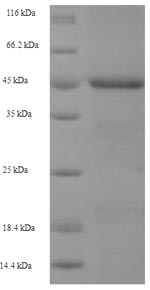The expression region of this recombinant Human NAIP covers amino acids 60-345. This NAIP protein is theoretically predicted to have a molecular weight of 48.6 kDa. Expression of this NAIP protein is conducted in e.coli. Fusion of the N-terminal 6xHis-SUMO tag into the NAIP encoding gene fragment was conducted, allowing for easier detection and purification of the NAIP protein in subsequent stages.
Human baculoviral IAP repeat-containing protein 1 (NAIP) is crucial for innate immunity, acting as a sensor for intracellular pathogens. NAIP, part of the NLRC4 inflammasome, recognizes bacterial flagellin and type III secretion systems, triggering inflammatory responses and antimicrobial defenses. In infectious disease research, studying NAIP provides insights into host-pathogen interactions. Its association with autoinflammatory diseases links NAIP to autoimmune research. Moreover, understanding NAIP contributes to the broader field of inflammasome biology, offering potential therapeutic targets for immune-related disorders. Investigating NAIP's diverse functions provides a comprehensive understanding of its roles in immunity and various pathophysiological conditions.






